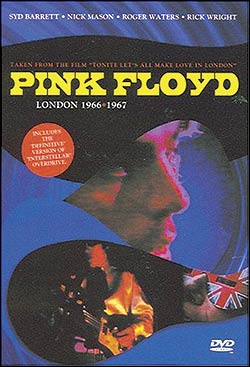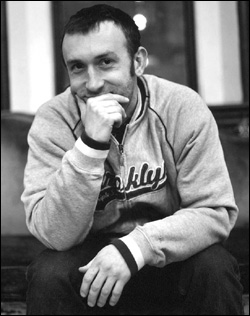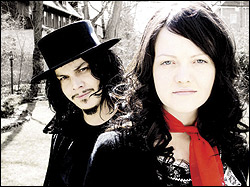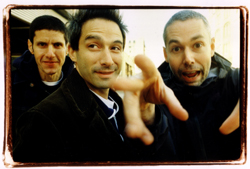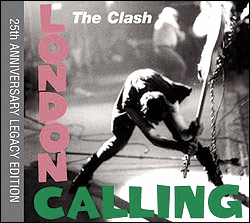Icons, dinosaurs, spacemen, prog- rockers, prop-rockers, hi-fi christeners, bong salesmen, punk rock’s nemeses, the Big Story of Live 8: Pink Floyd have been called a lot of things, but for some reason “populist” continues to escape them. Overly elaborate stage shows and album-side-length epic rock suites have been considered pretentious and irrelevant since Joey Ramone’s first 1-2-3-4, but ironically the one thing that drove Pink Floyd, even through all their high-tech audiophile multimedia grandiosity, was their need to reconnect with some universal human reality that their original frontman, Syd Barrett, had since abandoned. They reconnected so well with 1973’s The Dark Side of the Moon that they sold 30 million copies and counting, made the avowedly socialist Roger Waters a multi-ultra-millionaire, and kept Johnny Rotten from having to wear an “I Hate ELO” shirt.
Yet all of that was unthinkable in 1968. A couple years prior, the Pink Floyd (every rock group had a mandatory “the” back then) were the It band to grok when you were caught up in the transitory phase between swingin’ London mod and acid-dropping psychedelia, halfway between The Avengers and 2001. The new DVD Pink Floyd: London 1966/1967 (Navarre Corporation, $20.98) is both an interesting snapshot and a superficial overview of that incarnation. It’s more the story of a scene than it is of the band, and the main footage of the Floyd—culled from the classic documentary Tonite Let’s All Make Love in London and rife with footage of trippily shot neon lights and midriff-baring go-go girls—feels almost perfunctory. Only two songs are featured, and while it’s a thrill to hear both the first draft of “Interstellar Overdrive”—replete with a more prominent, grimier Rick Wright organ hook that could have come from ? and the Mysterians’ garage—and the meandering proto- Krautrock of the beat-drone/sound-decay exercise “Nick’s Boogie,” both songs are instrumentals and lack the pastoral whimsy that Syd brought to the group.
The periphery is of greater interest here. There’s footage of the band’s April 1967 gig at Alexandra Palace, the place where John Lennon supposedly met Yoko Ono, and the interview extras—while largely irrelevant to Pink Floyd, save a somewhat dry overview by rock video pioneer/director Peter Whitehead —are a hoot, particularly footage of Michael Caine bemoaning miniskirt morals and a dazed-sounding Mick Jagger mumbling vague social philosophy like a man about to decide that it would be a good idea to make Her Satanic Majesty’s Request. We also get to see a clip of some guy wearing a small chain-link fence wrapped around his face and a woman taking a drag on a cigarette while a flower dangles from her mouth; they both look pretty nonchalant about the whole thing. Syd Barrett, meanwhile, could no longer look nonchalant about anything. Being a pop star was burden enough, but once a housemate turned him on to acid, his pre-existing schizophrenia became too much to handle, and the band drifted, rudderless, without him for the next several years.
They’d sort that out eventually. John Harris’ The Making of the Pink Floyd Masterpiece ‘The Dark Side of the Moon’ (Da Capo, $24.95) dredges up every possible relevant bit of information on the background and creation of their breakthrough album, and puts as much emphasis on the years leading up to their 1973 blockbuster as it does the actual recording sessions. Harris’ matter-of-fact narrative, augmented by the band’s often amusingly irascible recollections, reveals a fascinating evolution.
Waters’ recurring sense of isolation and detachment—”I haven’t even begun to find how to relate myself to the rest of the world, and people, and what to do about them,” he’s quoted from a 1970 interview—finally pushed the band to embrace down-to-earth themes as a way of grounding their own heads. They had already spent the better part of an international tour working out the album’s kinks—often riddled with technical difficulties Waters referred to as “severe mechanical and electronic horror”—and in 1972, they set up a strange encampment in Abbey Road Studios, where yards of unedited sound-effects audio tape were looped round the room’s circumference around microphone stands during sessions that were timed to not conflict with episodes of Monty Python.
Harris, also the author of last year’s excellent Britpop! Cool Britannia and the Spectacular Demise of English Rock, touches on a range of trivia—David Gilmour’s attempts to bring some Stax style into the proceedings with “Money,” session singer Clare Torry’s skeptical view of her vocals on “The Great Gig in the Sky” (brought in to replace clips of the U.K.’s Pat Robertson analogue, Malcolm Muggeridge), the Paul McCartney spoken-word quips that were left off the album because he “found it necessary to perform” instead of answering the written questions (e.g., “What is on the dark side of the moon?”) straight.
But most of all, Harris makes it clear why the album was such a success: It’s grandiose music augmented by unpretentious language. Dark Side, like the Lamborghini Countach and the set design for Star Wars, is both exotically high-tech and dated in a way that only a product of the ’70s can be. But leave aside the album’s stoner-rock rep, from the laser shows it soundtracks to its alleged resonances in tandem with viewing The Wizard of Oz (an urban myth parodied by East Orange, N.J., free-form radio station WFMU host Tom Scharpling, who recently played Dark Side in its entirety with running commentary). Focus instead on its combination of studio wizardry and plainspoken pop lyrics, and you can hear the album for what it is: Pet Sounds for pessimists.
